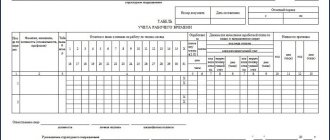08.07.2019
0
143
4 min.
Working time is the period allocated for performing work duties. The law limits weekly work hours to 40 hours. The actual hours worked are subject to recording in a report card, register, schedule or other document of similar content. Not only labor time is recorded, but also absences for valid reasons and without them. The employer has the right to decide independently how vacation, sick leave and any other break in working time is indicated on the timesheet. Unified forms are accepted and widely used, but their use is not mandatory.
Working time and its recording
Recording of working time is mandatory; this rule is stated in Article 91 of the Labor Code of the Russian Federation. The responsibility for maintaining records rests with the employer. Working time is calculated in order to determine whether the employee has developed a standard. In the case of overtime, he must receive monetary compensation or time off, and if he does not work enough, he will not be able to count on receiving the established salary in full.
Working hours are counted in several main ways:
- Day by day.
- Weekly.
- Summarized.
Daily accounting is carried out if the hired person has a strictly established schedule, works full time and goes to work at the specified hours, while having the same shift length. Time is counted weekly if a person works part-time and has a flexible work schedule. The condition for such calculation is the same number of working hours per week. The summed count allows you to use one and the other method simultaneously, depending on the need, and take into account hours worked out of order.
How are holiday days designated?
If, when an employee is on annual basic paid leave (PA) or on annual additional paid leave (AP), a public holiday falls during the period of his rest, in the report card the OT or OD code must be replaced with B (weekends and non-working holidays), because that, in accordance with Article 120 of the Labor Code of the Russian Federation, non-working holidays falling during the period of paid leave are not included in the number of calendar days of leave.
Time sheet
To systematize accounting, organizations maintain special timesheets. They are intended to reflect the actual situation of the presence or absence of hired persons. A time sheet is a blank form in which information is entered daily about hours worked, weekends, holidays, vacations, sick leave and other issues for each employee individually.
In Russia, the Labor Code establishes that a person must work 40 hours a week, provided that he works five days a week or 36 hours in a six-day week. These norms must be strictly followed, although employers do not always have the opportunity to fulfill the norm on a weekly basis, but in total, the required number of hours must be completed per month or quarter.
The report card allows you to solve a number of issues:
- Control labor discipline.
- Standardize the length of the work week.
- Calculate the total duration of overtime work and timely, and most importantly, compensate for it in full.
- Take into account weekends and holidays.
Each of the financial indicators is calculated using separate formulas and schemes, and therefore requires different marks on the form.
Main purpose of the document
A time sheet is a multifunctional document despite the simplicity of the form itself and the way it is maintained.
The main purpose of the paper is to ensure that the employee has worked the established number of hours according to the law and schedule. However, in addition to this important purpose, the document also performs other functions.
The timesheet has the following additional purpose:
- Allows you to receive and process data on how many hours an individual employee worked.
- Makes it possible to calculate how much actual time was spent on work, weekends, downtime, disability, vacation periods, and more.
- Allows monitoring compliance with established labor regimes.
- Allows registration of absenteeism without reason and through the fault of the employer.
- Provides the ability to conveniently calculate remuneration due for time worked.
In addition to all the above functions, this document makes it possible not only to immediately assess the labor situation, but also to draw up statistical reports on labor.
General rules of conduct
At first glance, a completed work time sheet does not raise any questions, but when entering information into it initially, the person filling it out may have problems. The document requires taking into account many nuances.
Let's start with the fact that each employee must be assigned personnel numbers. This number is assigned not only to the person himself, but also to the workplace he occupies. That is, if an employee works at his main place of work and simultaneously holds another position, then he must be registered as a part-time worker and receive another personnel number. This will allow him to be counted twice on the form and his salary to be calculated for two positions, and not for one.
No-show marks are initially placed solely on the basis of available information, but then the specified data must be documented. If a confirmation document is missing, the data is corrected to what is actually available.
Upon dismissal, the employee is excluded from the count for the month following termination of the contract. When hiring a new person, he must be included in the form in the month in which he actually began to perform his labor functions.
Page not found
Timesheets are mandatory for both enterprises and individual entrepreneurs. For its absence, administrative liability is provided for the enterprise itself and the responsible persons. If your management does not know about a simpler system for recording working hours, then it’s time to offer it to them. Keeping a time sheet on a computer In addition to the paper version, there are also several electronic ones. As mentioned above, timesheets must be duplicated.
This is necessary to ensure that data on the work of employees is not lost and their accuracy is confirmed (after all, it is not possible to use a computer everywhere).
Unified forms
Goskomstat has developed unified forms that allow you to easily and quickly enter information about hours worked. There are only two such forms:
- T-12.
- T-13.
They have different purposes, although they are identical in terms of information content. The unified form T-12 allows you to fill out the form itself manually. To do this, the document is simply printed or purchased, and then filled out monthly. Form T-13 was developed and implemented for special electronic accounting. It implies the presence of automated checkpoints that read information about incoming and outgoing passengers and enter the time and dates of such visits. Additionally, information about absence is entered into the program.
The presented unified forms are not suitable for all employers. They allow you to take into account working hours in those organizations that have time wages. If there is a piecework system for calculating earnings, then you should develop your own forms. When developing them, you can focus on existing samples, which are supplemented, if necessary, with other graphs and cells.
Filling rules
The document is completed taking into account special rules. The form is always kept in one copy, and the data is entered virtually date to date.
Let's consider the step-by-step entry of information into the form:
- Name of the organization.
- Structural unit, if the company maintains more than one form at the same time.
- Document Number. Numbering begins at the beginning of the calendar year and resets to zero at its end.
- Compilation date – the last day of the reporting period.
- Month of accounting.
- The sequence number of the line.
- Full name of the employee in expanded form.
- Personnel Number.
- In columns 4, 5, 6, and 7, actual appearances and absences should be noted.
- Column 8 indicates the number of days worked.
- Next is a breakdown by hours - how much was worked, including nights, overtime, weekends and holidays.
- The 14th column indicates the total number of no-shows for the reporting period.
The report card is signed first by the responsible person who compiled it, then by the head of the structural unit, and the final signature is the signature of the head of the HR department.
What is needed to account for study leave?
The first step is proper design. Based on correctly prepared and registered documents, study leave in the time sheet will be correctly granted. Based on this data, the accounting department will be able to calculate vacation pay if additional vacation is paid.
We list the main documents required by the personnel service:
- personal statement of the employee signed by the manager;
- order on granting study leave;
- certificate of challenge from the educational organization.
They must contain all the information for registration and accounting:
- name of the educational organization, form of education, course;
- availability of accreditation;
- the purpose of providing rest is the type of educational employment;
- period and duration of absence due to study in calendar days.
Information about registration of additional leave is recorded in a personal card. As a rule, it is carried out according to the standard form T-2 (information of the Ministry of Finance of the Russian Federation dated December 4, 2012 No. PZ-10/2012). Since 2012, employers can use independently developed forms.
In the T-2 form, this information is entered in section 8. Let's give an example.
| Type of vacation | Duration of vacation | Base | ||||
| With | By | Start | ending | |||
| 1 | 2 | 3 | 4 | 5 | 6 | 7 |
| Training | 01.02.2019 | 10.02.2019 | 10 | 01.02.2019 | 10.02.2019 | Help call No. 98 dated 01/12/2019 Order No. 12 dated January 31, 2019 |
Designations in the report card
The largest number of errors when maintaining time sheets is recorded when filling out the columns about time worked.
This is due to the fact that many people are confused about which code to put in this or that case, although the form itself contains information about the most common abbreviations. In addition to generally accepted meanings, you are allowed to enter your own personal symbols, the main thing is to use them systematically and ultimately not get confused with the accounting.
The hours actually worked are shown on the timesheet as follows (letter code/numeric code):
- Daytime – I/01.
- Night shifts – N/02.
- On calendar days off and official holidays - RP/03.
- Overtime worked – C/04.
- Watch – VM/05.
- Business trip days – K/06.
The following tables of symbols give two meanings for each case: digital and alphabetic. The employer decides which one to use.
Vacation
The designation of vacation in the report card involves the use of special codes, which vary depending on the type of vacation booked.
Here's how vacation is written on the timesheet:
- The regular holiday provided annually is OT/09.
- Additional vacation periods – OD/10.
- Additional allowance allocated for training while maintaining the average salary - U/11.
- Additional days for study are unpaid - UD/13.
- Maternity leave for pregnancy and childbirth - P/14.
- Maternity leave for caring for a newborn – OJ/15.
- Administrative leave in agreement with the employer - DO/16.
- Days without pay provided by law - OZ/17.
- Annual additional leave, which is issued without payment - DB/18.
The variety of vacation periods must be correctly indicated on the form, because each of them is paid differently.
Absenteeism
You cannot skip work; such an action entails negative consequences in the form of a reprimand or even dismissal. However, this does not negate the very possibility of such a phenomenon. Absenteeism must be noted on the report card as follows: PR/24.
But there are other absences that, although they are not days off or vacation, nevertheless do not mean unauthorized absence. They should be specified like this:
- Forced absenteeism due to dismissal or transfer to another workplace being declared illegal - PV/22.
- Absence from work due to the performance of government duties – G/23.
- Suspension from work with payment of benefits – NO/34.
- Prohibition of work without payment – NB/35.
- Suspension of performance of one’s duties due to delay in salary – NZ/36.
- Strike – ZB/29.
Absenteeism can be put on the report card only if there is evidence of this fact; usually this is done after a commission act is signed or an explanatory note is given by the truant. Until the circumstances are clarified, you should take some time and enter NN or 30, which means an unidentified reason for absence.
Sick leave
Sick leave is entered on the report card first in advance. Usually, when an employee falls ill, he notifies the employer, although such a norm is not established by law, it is practiced in the majority of cases. The employer, knowing that the employee is sick, puts the letter B or the number 19. This code means that the time of incapacity for work is a confirmed ballot and will be paid. This fact can be confirmed only after submitting the certificate of incapacity for work to the accounting department. Sick leave can be provided only after it is closed, therefore, no matter how sick a person is, all these days are given a B or 19.
When a person returns from sick leave, he submits a ballot and after it is checked for authenticity, the code is either confirmed or a different code is entered. If the ballot was false, then absenteeism is given. But it may also be that the form is real, but not subject to payment. This happens if the patient had violations of the hospital regime and received the appropriate marks. In this case, T or 20 is set, and payment is not charged.
General concepts
The time sheet plays an important role in the operation of the enterprise, from recording employee attendance at the workplace to calculating their wages.
Each event has its own special code, which can reflect the time of the working day, illness, business trip, vacation, including lateness and absence of the employee from work. In addition, this document allows you to track the norms of the working week and make certain adjustments to the work process.
We invite you to familiarize yourself with the Difference between the areas of responsibility of the owner and management company - 2020
Thus, based on the report card data, the manager can make certain decisions on changing the employee’s work week if there is overtime; this can quite often occur with a flexible schedule or replacing a sick employee. Also, based on the report card data, you can make a decision both on bonuses and incentives for the employee, and on depreciation and imposition of penalties.
Please note that the first part of the timesheet, for the first half of the month, is submitted to the accounting department to calculate advance wages, and based on the fully completed timesheet, a full calculation of wages is made.
Who is responsible for maintaining records?
Responsibility for timesheets can be assigned to different employees, it all depends on the number of employees working in the organization. Large enterprises have the following responsibility structures:
- Each department has its own designated specialist who maintains records during the reporting period.
- All timesheets flow to one responsible person, who checks the information and correctness of completion. This could be a personnel officer, an economist, an accounting engineer.
- The verified data is transferred to the accounting department for payroll.
In small-format organizations, timesheets are carried out immediately by a personnel employee, secretary or even accountant.
Responsibility for lack of accounting
Responsibilities for maintaining specialized timesheets are imposed officially and are stated in the job description or even in the employment contract.
The responsible employee will be responsible for the incorrect entry of information or even complete absence. Legislative norms provide for administrative penalties.
When classifying an identified offense as a violation of the law on labor and labor safety, the Code of Administrative Offenses in Article 5.27 provides for a fine:
- From one to five thousand rubles to guilty officials.
- The same amount of fine or suspension of activities for up to 90 days for individual entrepreneurs.
- From thirty to fifty thousand to legal entities.
An initially detected violation may only result in a warning, but a repeated violation may result in the specified fines.










